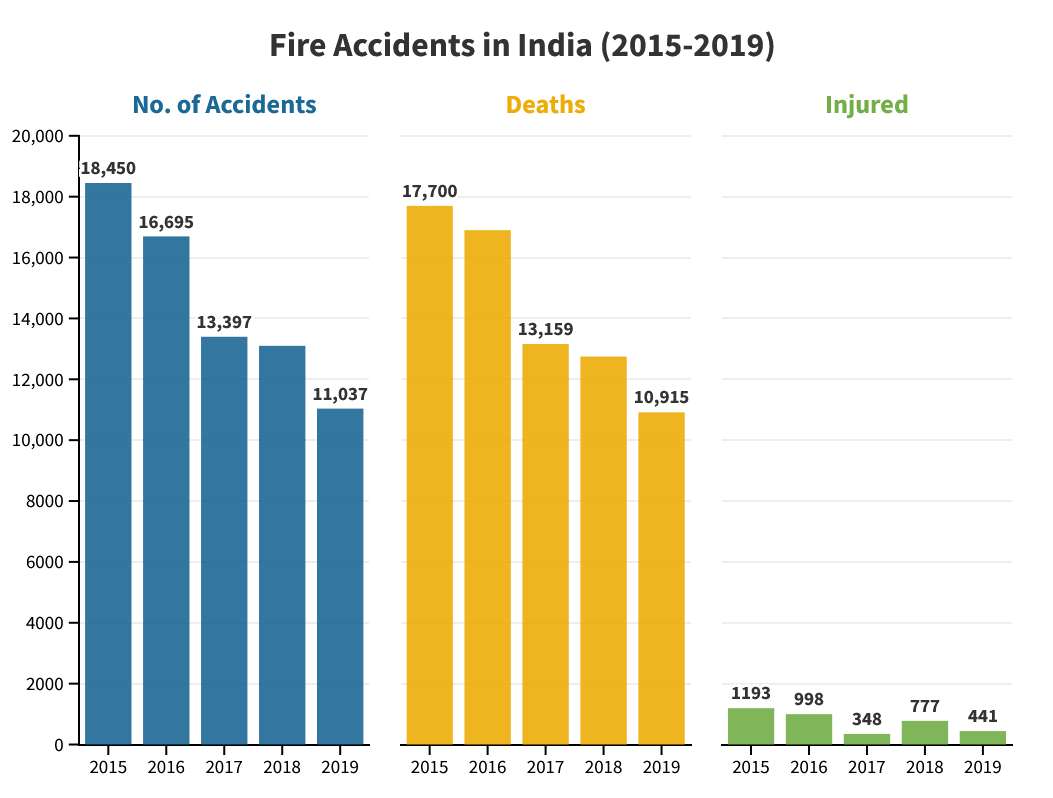According to National Crime Record Bureau, a total of 11,307 cases of fire accidents were reported in India between 2015-2019, with 441 persons injured and 10,915 killed. The cause-wise analysis of fire accidents concluded that 61.4% of deaths were due to fire accidents in residential buildings due to safety measures not in place.

Fire service is one of the most predominant emergency response services in the country, which comes under the 12th Schedule of the constitution dealing with Municipal functions. Presently, fire prevention and fire fighting services are organized by the concerned States and Union Territories (UTs), and Urban Local Bodies (ULBs) where Directorate of National Disaster Response Force and Civil Defense (NDRF&CD, Fire Cell), Ministry of Home Affairs (MHA) render technical advice to the States, UTs, and central ministries on fire protection, prevention, and legislation.
Hence, Haryana Fire and Emergency Services Act, 2022 (hereinafter referred as “The Act”) came into force on 7th of April 2022 which has repealed Haryana Fire Service Act, 2009.The Act provides the provisions for the greater prevention of fire and fire safety measures in the buildings, in accordance with the Part-IV of National Building Code 2016. Part IV of National Building Code provides for safety from fire.
The Act is applicable on person who is involved in Fire and Emergency Services, Owner or Occupier of a building and all the buildings, where a building is Constructed, Altered, Demolished, and Renovated.
TYPES OF BUILDING COVERED UNDER THE ACT:
The Act classifies building into the following types:
- All high-rise buildings (except residential buildings up to a height of 16.5 meters).
- Special buildings include:
- Hotel, educational, institutional, business, mercantile, industrial, storage, hazardous and mixed occupancies, where any of these buildings have a floor area of more than five hundred square meters (500 square meters) on any one or more floors;
- Educational buildings having a height of nine meters (9 meters) and above;
- Institutional buildings having a height of nine meters (9 meters) and above;
- All assembly buildings;
- Buildings, having an area of more than three hundred square meters (300 square meters) of incidental assembly occupancy on any floor;
- Buildings with two basements or more, or with one basement of an area more than five hundred square meters (500 square meters) unless otherwise mentioned specifically in the provisions.
DIFFERENCE BETWEEN THE FORMER LAW AND THE NEW LAW:
| Haryana Fire Service Act, 2009 | Haryana Fire and Emergency Services Act, 2022 |
|---|---|
| Any person proposing to construct a building shall apply for the approval of the Fire Fighting Scheme in accordance with National Building Code of India, Disaster Management Act, Factories Act, 1948, and the Punjab Factory Rules, 1952, and issue of no objection certificate on such form, along with such fee, as may be prescribed. | Any person proposing to construct a building after approval of building plans shall apply for approval of the fire fighting scheme confirming the provisions of this Act and Part- IV of the National Building Code of India, 2016 as revised from time to time. |
| The provisional no-objection certificate shall be issued within 60 days of submission of the application by giving all the details of the construction being undertaken as well as the rescue, fire prevention and fire safety details required to be incorporated during the period of construction. And, on completion of construction of the high-rise building, a no-objection certificate shall be obtained, which shall be valid for 5 years. | There is no such provision mentioned in the Haryana Fire and Emergency Services Act, 2022 for the no-objection certificate. |
| The Government may, by notification, declare that no place within the area, as may be specified, shall be used for any one or more of the purposes, which in its opinion constitute a fire risk and the owner or occupier of any place used for one or more of the purposes mentioned in the notification shall make an application for the license. | There is no such provision mentioned in the Haryana Fire and Emergency Services Act, 2022. |
| Any person who contravenes, any provisions of this Act or any rule shall be punishable with imprisonment for a term which may extend to 3 months, or with fine which may extend to Rs. 5000 or with both. | Any person who contravenes, any provisions of this Act or any rule shall be punishable with imprisonment for a term which may extend to 3 months, or with fine which may extend to Rs. 10000 or with both |
Haryana Fire and Emergency Services Act, 2022 repealed Haryana Fire Service Act, 2009 to ease the procedural aspect regarding obtaining the Fire NOC, Fire Safety Certificate, and Fire Fighting Scheme.
- The provision to get the NOC by the owner on the completion of the construction of high rise building and in the absence of such certificate, the owner was not permitted to occupy, lease or sale the building. Further, the NOC was suppose to be renewed every year. So, the entire process was time taking and caused undue harassment to the applicant. Therefore, the amendment will help in addressing substantial number of grievances relating to the NOC
- Now, the owner or occupier of the building shall give a Self-Declaration Certificate annually to the affect that the fire fighting system installed in his building is working in good condition. Also, there is no addition or alteration in the building, as per the Act
- Lastly, by increasing the penalty, the state aims a duty to protect the public from future wrongs or harms, and that such protection can be afforded through some form of incarceration. It might subside future fire accident cases.
CASE STUDIES
1. Delhi Mundaka Fire
Fire broke out in a Mundaka’s commercial building in May, 2022 because of an electrical short circuit on the 1st floor which soon spread to the other floors, and later the flames engulfed the entire four-storeyed building. According to the reports, 29 died and 12 got injured in the incident. Owners and the tenants both have been arrested due to inadequate provisions of fire fighting in the building.
The problems:
- The building was built on a land for residential purposes, but was functioning as a commercial building
- The owners had no NOC (No Objection Certificate) from Delhi Fire Services
- There was only one narrow staircase that served as entry and exit from the ground to the top floors
- Fire extinguishers and fire safety alarms were absent in the building, that was being used as a space for offices, factory and godowns.
2. Anaj Mandi Fire Tragedy – Delhi
On December 8, 2019, Delhi woke up to a massive fire at Anaj Mandi factory building. The four-storey building was cramped with sleeping labourers. The fire broke out on the 2nd floor of the building around 5 am. In the incident, 43 people lost their lives and 16 were injured.
The problems:
- Even after receiving several fire emergency calls, the concerned authorities didn’t take any required actions against the illegal constructed factories being run as the building was built on a land for residential purposes
- There were only 2 exit doors, amongst which one was blocked
- Negligent conduct of the owners with respect to fire
- The building was packed with combustible material like card boards, plastic wrappings, garments, rexine, plastic toys, packaging materials, aggravating the fire and resulting in dense smoke which suffocated the people trapped inside
- Windowless rooms, narrow staircase which trapped the smoke.
The Common Measures to be taken in the case studies:
- Illegal constructions and unplanned infrastructure need to be checked by the competent authorities. It is the duty of authorities to ensure compliance
- Regular audit of buildings and enforced regulations in such urban centers. Building by-laws should not be infringed
- Accountabilities for employees should be fixed at all levels
- Political will to improve the working conditions
- Emergency disaster drills in such urban centers
- Political will to improve the working conditions.
Fire incidents in Delhi reports how India’s urban centers have time and again failed to meet the rudimentary fire safety norms. Tragic and disastrous fire incidents in Delhi which have taken place before such as at Uphaar Cinema in 1997, the Lal Kuan fire tragedy 1999, and Hotel fire in Karol Bagh in 2019. The point is that these buildings and localities are sources of livelihood for a substantial section of the city’s population but they are unregulated.
CONCLUSION
In general, fire risk is defined as the combination of hazard potential, exposure, and vulnerability:
Risk = F (Hazard potential x Exposure x Vulnerability)
The occurrence of fire incidents that constitute a threat for the population and exposed infrastructure of a certain region is associated with economic and human losses, always as a function of the exposure conditions and the vulnerability of the exposed assets in that particular region. Hence, the Government should inspect all schools, colleges, hospitals, hotels, auditoriums, coaching centres, cinema halls, hostels commercial buildings and multi-storey complexes within a time-span to ascertain if fire safety norms are being followed or not and to aware public about fire safety measures by organizing regular fire drills. The fire services in the State should have a routine audit by a central authority to ensure good finance mechanism for capital, and O&M expenditures.
Source
Report by RMSI for Directorate General NDRF & Civil Defence (Fire) Ministry of Home Affairs
Newspaper snippets from The TOI, The Business Standard and The Hindu
Report National Crime Record Bureau’s ADSI Report
Bare Act from Haryana Government, Law & Legislative Department
Disclaimer
The information provided in this article is intended for general informational purposes only and should not be construed as legal advice. The content of this article is not intended to create and receipt of it does not constitute any relationship. Readers should not act upon this information without seeking professional legal counsel.


